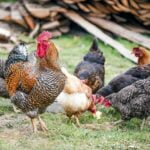Beyond “Cock-a-doodle-doo”: What’s the Message?
Roosters are renowned for their daybreak serenades, but their crowing isn’t just a random wake-up call. It’s a complex language, vital for flock dynamics and survival. From territorial disputes to seduction techniques, each “cock-a-doodle-doo” holds a distinct message, decipherable by those who listen closely.
While often associated with dawn, a rooster’s crow can occur throughout the day, each with its own purpose and urgency. Understanding these nuances empowers chicken owners to better interpret their flock’s needs and behaviors.
I. Crowing: A Multifaceted Language
Crowing is instinctive in roosters, driven by hormones and serving multiple purposes:
- Territorial Proclamation: Like a feathered town crier, a rooster’s crow warns rivals of his presence, establishing dominance and preventing potential conflicts.
- Mate Attraction: Crowing acts as a powerful mating call, signaling virility and attracting hens. It’s the rooster’s way of saying, “Hey ladies, check out this guy!”
- Flock Communication: From signaling the start of the day to alerting the flock to potential dangers and even announcing a tasty worm discovery, crowing is the glue that holds the flock together.
II. Deciphering the Message: Context is Key
Think of it like this: the meaning of a crow changes depending on the time of day, the rooster’s body language (is he strutting? anxious?), and the presence of other chickens.
Here are some common crowing scenarios:
- Dawn Chorus: Often starting before sunrise, the head rooster initiates this iconic chorus, followed by subordinates in a hierarchical order. This reinforces their social standing, warns potential rivals, and encourages the flock to begin foraging.
- Response Crowing: Throughout the day, roosters engage in “crowing conversations,” responding to each other to maintain territorial boundaries. The intensity and frequency can indicate the level of aggression or agitation. Imagine it like a feathery debate!
- Mating Calls: To woo a potential mate, roosters use a specific crow, often paired with a strutting display and wing-fluttering. It’s their way of saying, “Look at me, I’m the rooster for you!”
- Alarm Calls: A shorter, more urgent crow signals danger to the flock, urging them to take cover. Think of it as their version of a security alarm.
III. Crowing and the Pecking Order
- Crowing as a Hierarchy: Crowing isn’t just about making noise; it’s about establishing who’s boss. The dominant rooster typically crows most frequently and intensely, solidifying his place at the top.
- Multiple Roosters, Multiple Challenges: Having multiple roosters can lead to increased crowing due to territorial disputes and competition for mates. It’s like having multiple singers competing for the spotlight!
IV. Beyond the “Cock-a-doodle-doo”: Nuances and Insights
- Not All Crows Are Created Equal: Roosters have different vocalizations, varying in pitch, length, and repetition. These subtle variations, like regional dialects, convey specific information to other chickens.
- Factors Influencing Crowing Frequency: A rooster’s age, breed, individual personality, and even environmental factors (like light, weather, and stress) can influence how often he crows.
V. Why Do Roosters Crow at Dawn?
This age-old question has fascinated people for centuries. While crowing occurs throughout the day, dawn is peak crowing time due to a fascinating interplay of biological and social factors.
- Biological Clock at Work: Roosters, like many animals, have an internal circadian rhythm that dictates their sleep-wake cycle and influences crowing patterns. They don’t crow solely because of sunlight, but possess an internal alarm clock.
- Hormonal Surge: Testosterone levels in roosters peak in the pre-dawn hours, contributing to increased crowing urges upon waking.
- Light Sensitivity: While not entirely reliant on it, roosters are sensitive to light changes. The first hint of dawn triggers a hormonal response that can induce crowing.
But it’s more than just biology at play:
- A New Day, A New Competition: As a new day begins, competition for food, mates, and prime territory intensifies, leading to more frequent and intense crowing. It’s the rooster’s way of saying “I’m here, I’m ready, let’s go!”
- Flock Synchronization: In the wild, this dawn chorus was crucial for survival. The rooster’s crow served as a wake-up call for the flock, synchronizing their foraging activities during safer daylight hours and potentially deterring nocturnal predators.
VI. Addressing the Noise: Understanding and Mitigation
Crowing is a natural, instinctive behavior for roosters and cannot be entirely eliminated. However, there are ways to manage the noise:
- One Rooster Rule: Keeping only one rooster minimizes territorial disputes and reduces the overall crowing “chorus.”
- Space to Roam: Providing ample space reduces competition for resources and can lead to a calmer, quieter flock.
- Soundproofing Solutions: Consider soundproofing measures in your coop to minimize noise pollution for yourself and your neighbors.
- Consult the Experts: Experienced poultry keepers can offer valuable advice and strategies tailored to your specific situation.
VII. Delving Deeper: The Untold Stories of Crowing
While we’ve learned much about rooster communication, many fascinating questions remain:
- Evolutionary Advantage: How did crowing at dawn provide a survival advantage for wild chickens? Was it purely for foraging coordination, or did it play a role in predator avoidance?
- Crowing Across Cultures: The rooster is a potent symbol across cultures, often associated with dawn, awakening, and good luck. Exploring these cultural connections adds a rich layer to understanding these birds.
- From Chick to Chanticleer: How and when does crowing behavior emerge in young cockerels? Documenting this development could provide valuable insights for breeders and enthusiasts alike.
- Beyond the Bird: Crowing Comparisons: How does the rooster’s dawn crowing compare to similar territorial signaling in other bird species, or even mammals?
By exploring these untapped areas, we can gain a deeper appreciation for the fascinating world of rooster communication and the symphony of sounds that fill our mornings.
VIII. Do you want to discover more about the captivating world of rooster behavior?
Why do roosters crow in the morning? Dive deeper into the science behind their sunrise serenades and uncover the secrets of the coop. You might even learn a thing or two about whoopin feet along the way!
- Long Haired Gray Cat Breeds: The Ultimate Guide - April 7, 2025
- How Many Days Until Feb 2: Accurate Countdown & Tool Guide - April 7, 2025
- Uncover the 7th Month: A Deep Dive into July’s History - April 7, 2025

















2 thoughts on “Why Does a Cockerel Crow? Unraveling the Reasons Behind the Call”
Comments are closed.